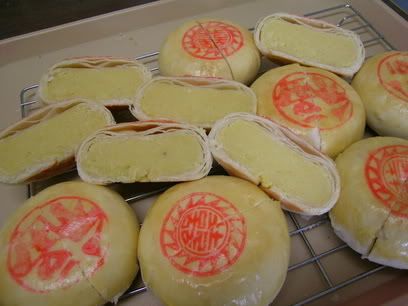
The Oil Mixture for Making Pastry:
-90g lard
-90g oil
**Stir together over high heat until the lard completely melts. Cool completely before using to make pastries. Can also make pastries with 100% oil, but the combination of lard and oil gives the pastry much better flavor and texture.
Water Dough:
-250g bread flour
-50g wheat starch
-40g sugar
-100g “oil mixture”
-120g water
-1/2 tsp baking powder
**Mix together bread flour, wheat starch, and baking powder. Stir together oil, water and sugar, and add to premixed flour. Knead to form a smooth dough (about 10 mins). Rest for ½ hour and divide into 12 portions weighing about 50g each.
Oil Dough:
-75g tapioca starch
-75g bread flour
-75-80g “oil mixture”
**Mix everything together and divide into 12 portions weighing approximately 20g each.
Filling:
There are many different versions of fillings, pick one of the following.
Vietnamese Style (Mung beans and Durian)
-450g mung beans (peeled and split)
-350g sugar
-100g oil
-150 koh fun (cooked glutinous rice flour)
-200g durian flesh
-100g pork fat + 50g sugar (optional)
-12, 24 or 36 salted egg yolks + 1 tbs cooking wine (optional)
**A) Boil pork fat for 5 mins, and cut into match stick size pieces. Mix with 50g sugar and let rest for at least ½ hour before using.
B) Mix egg yolks with wine and steam for 15 mins. 1 yolk in each pastry = 12 yolks total, 2 in each pastry = 24 yolks total, etc….
C) Rinse and soak mung beans for at least 4 hours. Cook until tender and mash. Add sugar and durian. Stir fry over medium heat for about ½ hour. Add pork fat (A). Mix together koh fun and oil add to bean mixture. Stir fry for another 5 mins or until mixture thickens. Cool and divide into 12 portions, add and egg yolk (B) in the center.
Lotus Paste and 1000 Year Egg
-450g lotus seeds
-1 tsp lye water
-350g sugar
g candied wintermelon (tong dong kwa)
-100g oil + 50 koh fun
-12, 24, 36 1000 year egg yolks (optional)
**Soak lotus seeds with lye water and enough water to completely cover the seeds overnight. Next morning, drain, and rinse seeds and boil until tender and mash, add sugar. Cut candied wintermelon into small pieces. Stir fry lotus seeds over medium heat for about 20 mins, add candied wintermelon, koh fun and oil. Stir fry for another 5 mins. Cool and divide into 12 portions, add an egg yolk in the center of each portion.
Taro or Mung Bean:
-1kg taro or 1kg COOKED mung beans (500g if dried)
-400g sugar
-100g candied winter melon
-100g oil + 50g koh fun
-100g pork fat + 50g sugar (optional)
-12, 24 or 36 salted egg yolks + 1 tbs cooking wine (optional)
**A) Boil pork fat for 5 mins, and cut into match stick size pieces. Mix with 50g sugar and let rest for at least ½ hour before using.
B) Mix egg yolks with wine and steam for 15 mins.
C) Mix together Koh fun and oil.
D) Cut candied melon into small pieces. Steam and mash taro, add sugar and stir fry for 20 mins. Add candied melon, fat (A), and koh fun mixture (C). Stir fry for another 5 mins. Divide filling into 12 portions, add egg yolk in the center.
Finally...Making the Pastries:
1) Wrap 1 portion of the oil dough in the water dough.
2) Roll flat, and fold into thirds, roll again and fold into thirds once more.
3) Roll into a flat circle, with the edges thinner than the center. The dough should be just big enough or slightly smaller than the approximate width required to wrap the filling.
4) Wrap use the dough to wrap the filling, with one hand “pushing” the filling down into the dough, while the other hand “pulls” and eases the dough up to cover the filling (like making mooncakes).
5) Put the pastry face down on a flat surface (edges facing up). Use a pastry cutter or something flat and solid to slightly fatten the pastry.
6) Flip the pastry right side up and gently stamp with design stamp.
7) Arrange the pastries face down on a pastry sheet. Bake at 400’F for a few mins. Until dough lightens in color and the pastry (layers) starts to puff.
8) Flip the pastries so that they’re right side up, use a sewing needle to poke a few “steam vents”. Continue to bake at 400’F or another 15-20 mins until the pastry is puffy and the bottom is slightly golden.
9) Brush with egg wash and bake until shiny and slightly golden (another 5 mins)
Note:
-The pastry will taste better and have a better texture if aged at least overnight.
-the texture (firmness) of the water dough and the oil dough has to be the same.
-Do not press to hard, and make sure design stamp is not “soaking wet” when stamping on the design else the layers will stick together.
-baking at a low temperature will give you a hard pastry with little layers.
-the water dough needs to be kneaded thoroughly else, the pastry will be puffy like puff pastry but the layers will not be “peelable”.

7:15 PM |
Category: |
23
comments







Comments (23)
Wow, it's a pretty long process to make this pia...but I guess it's worth it? They look pretty, tt!
lin,
it's alot of work but totally worth it. ;)
Is it suppose to smell really bad? I received a package of them from a friend. But I can't bare the smell.
anonymous,
whether something smells bad or not is up to a person's preference :D. Your friend probably sent you ones with durian filling thus explains the smell. However, I actually think durian smells good, so if I were in your shoes...... :)
i m impressed...u r so brilliant, can cook so many dishes.i m a teochew singaporean...but i dont know how to make this pia.will try one day...so far my mum always buy.i love ur blog very much.thx for sharing with us ur expertise.
hello
i wish to know where do you buy the baking essentials?
tiy@wanadoo.fr
anon,
what are you looking to buy?
How do you purchase the salted egg yolks? I have seen them sold in Oriental store sold as a wholecase in their shells...thus, do you boil the whole salted eggs first, and then remove the yolks [to be used in the pastry later]? If this is the case, then after you removed yolks, then do you steam them in wine next? I haven't seen any salted yolks sold separately in the store. Many thanks!
http://pwmf.blogspot.com/2006/10/its-been-year.html
Do I have to use pork fat for the filling?
Do you have a recipe for just mung bean filling?
Thanks
sally,
you don't have to do anything you don't want to. Notice that the recipes says the pork fat is *optional*.
oh, ok thanks! But will it give the same texture to the filling without the pork fat? Is the fat koh measurement the same with no pork fat?
Hi TT,
I would like to know which baking powder you are using for Banh Pia, single or double rising? Thanks
IT
it,
which baking powder do you think would be appropriate for the recipe and why?
*hint* read the recipe, notice the amount of time needed to make the pastry before baking it. Look into single and double acting baking powders and how they work.
tt, so grateful to find your blog (in english)!
where might i purchase the design stamp? i'm 3 hrs drive from houston,tx. thnx ;)
you can use rubber stamps which are available at any craft store.
thanks for sharing
Wow, your recipe is so detail and I want to try this out someday. I just wondering how long can we keep it? Such as 3-4 days or longer?
Hi Hoang Tam,
I so lucky that i found your blog. I tried banh bao nuong sucessed.
Please, post traditional mixed nuts mooncake. please...
Ilove your recipes and it worked very well thanks you for sharing
Hi there. Would you bake the yolks before placing in filling? Like in mooncakes? I've never eaten this pastry before, so I'm not sure what the inside is supposed to resemble (even though I do see you have a photo, but I see you used no yolks). Thanks for the recipe :)
Hi Hoang Tam . thank you for sharing your recipe and expertise. can you tell me what it is wheat starch? Where can I find it? Is it a common starch or flour that I can find at the grocery store?
Sophia,
I prefer to steam the egg yolks before putting them in the the filling.
MyAnh,
wheat starch is wheat flour with the gluten taken out of it. You can find it at most asian grocery stores.